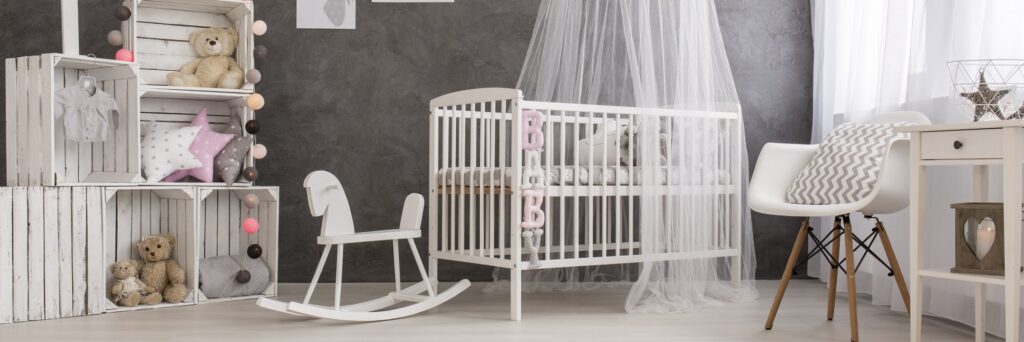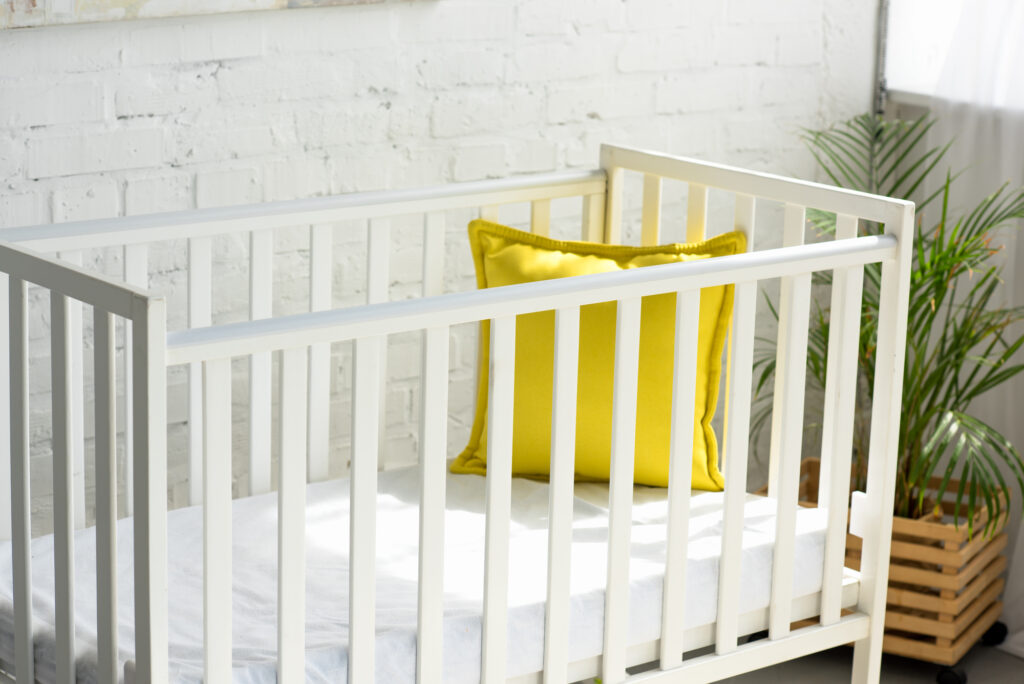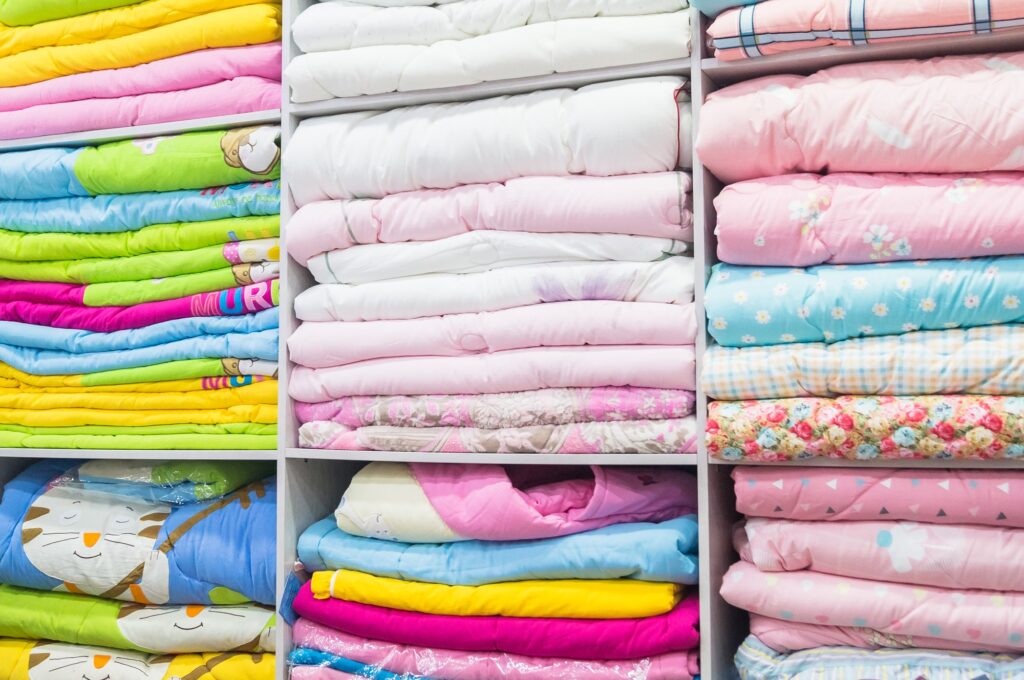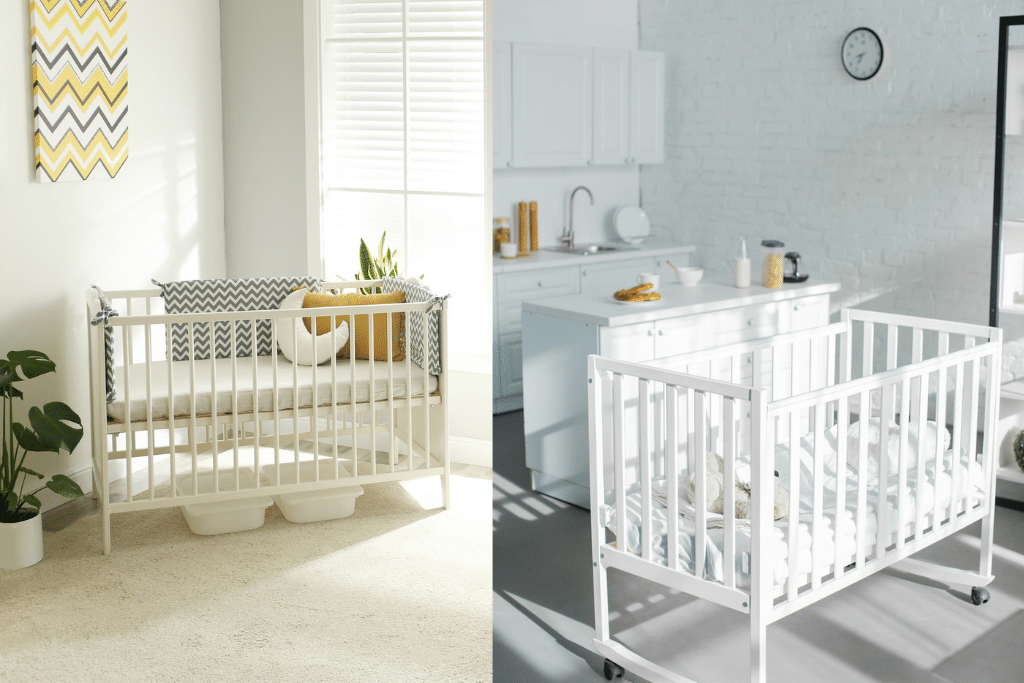If you’re like most parents, you are probably inundated with baby product options from the moment you find out you’re pregnant.
What sort of things will the baby need? How many should I buy? How long will this last? If you’re like me, you are probably also researching how to choose between a crib or bassinet for your newborn.
Moreover, I know those countless trips to the stores to check out different strollers and other accessories to make sure you have everything on your baby registry.
One thing that you’ll definitely need to prepare for, though, is where that baby will sleep once it exits your womb. Like most parents, you’ve probably scrolled through many of the options out there and come across the great debate: mini crib vs. crib.
This is why I’ve put together this guide so you could save time and become an expert in choosing a crib for your newborn.
- Mini Crib vs. Crib: The Basics
- Mini Crib vs. Crib: What’s the Difference?
- Mini Crib vs. Crib: Which Is Better?
- Mini Crib vs. Crib: What’s the Best Age?
- Mini Crib vs. Crib: Size Comparisons
- Mini Crib vs. Crib: Weight Limits
- Mini Crib vs. Crib: How Long Can a Baby Use It?
- Mini Crib vs. Crib: What’s Better for Toddlers?
- What To Look for in a Mini Crib vs. a Crib
- Mini Crib vs. Crib: Accessories
- So Is It Worth Getting A Mini Crib?
- Mini Crib vs. Crib: A Quick Rundown
- Mini Crib vs. Crib: Which Will You Choose?
Mini Crib vs. Crib: The Basics

Let’s start with the basics. You know that your baby needs a crib, but you may not have realized just how many options are out there. Most folks are familiar with a standard crib but may not know precisely what a mini crib is.
So what is a mini crib? As you might have guessed, a mini crib is a smaller version of a standard baby crib.
Standard cribs tend to be about 28 x 52 inches, whereas mini crib dimensions will be around 24 x 38 inches (exact measurements will vary, but this gives you a general idea).
Mini Crib vs. Crib: What’s the Difference?
So what’s the real difference when it comes to a mini crib vs. a standard crib size? Well, a lot.
Mini Cribs
We’ll delve into mini cribs first. The great advantage of having a mini crib over a standard crib is that most mini cribs are portable. As your baby grows over the first year or so, you’ll have the freedom to move their crib around the house.
Time to move the baby out of your room and into the world (or just their own room)? Need to have the little one nap somewhere other than the home office so you can get some work done? Not a problem with a mini crib.
Mini cribs are also an excellent option for parents who are short on space. If you’re struggling with finding enough room in a tight townhouse or apartment, mini cribs might be the option for you. Many mini cribs also come in round designs instead of rectangles, making them suitable for tight corners.
Standard Cribs
Standard cribs tend to be more of a furniture fixture. Standard cribs generally aren’t portable, so once you set them up in the nursery, you’ll need to disassemble them before you can move them again. Standard cribs can also be combined with a dresser for more storage space, although this makes them even larger.
Bassinets
Many new mothers wonder what’s better in the mini crib vs. bassinet battle. Contrary to what you might think, they are different things.
A bassinet is a raised sleeping surface specifically for a newborn infant. The raised-up feature is nice because it saves your back some trouble as you’re constantly bending down and picking your baby up. Both are portable.
Bassinets are great for infants as you could put the bassinet right next to your bed. Check out this guide listing the best bassinets for a small space.
Mini cribs generally aren’t raised up (although some are adjustable) and, as far as a newborn is concerned, aren’t any different from a regular crib.
Mini Crib vs. Crib: Which Is Better?
So the great debate, mini crib vs. standard crib size, continues. Which is better? Well, it depends on your needs.
Mini cribs are remarkable for setting up a nursery in a tight space. They’re also a good choice for mothers who want to have the baby sleep in the parents’ room.
Standard cribs also have their strengths. Since standard cribs are more oversized, they’ll last your baby longer. It’s also not uncommon for standard cribs to convert into a full-size bed, making them an investment that lasts through childhood.
Mini Crib vs. Crib: What’s the Best Age?
You may be wondering how long a baby can stay in a mini crib. The answer is that it depends.
Cribs of any sort will always have a weight and height limit from the manufacturer. For example, this Babyletto Origami Mini Crib recommends that parents stop using it once the child is 35 inches tall.
Other manufacturers suggest weight limits. DaVinci Baby, for example, says that all its cribs and mini cribs are safe up to 45lbs, but that parents should still stop using the crib when the child reaches 35 inches.
How Long Will a Baby Stay in a Mini Crib?
So what age are mini cribs good for?
According to Medical News Today, babies generally won’t reach 35 inches until well after their first year. Of course, this depends a lot on your family history and genetics, but the average American can expect a child to reach 35 inches around three years old.
That being said, it may be challenging to fit a three-year-old into a mini crib. Your child may find it uncomfortable and may just require more space for sleeping.
Mini Crib vs. Crib: Size Comparisons

Most standard cribs are around 53 x 30 x 37 inches (length x width x height). Mini cribs usually run around 36 x 24 x 33 inches (length x width x height).
Remember that regular crib sizes were standardized by law beginning in 2011. Mini cribs, bassinets, and the like aren’t standardized, so you’ll find much more variety in terms of sizes and dimensions.
Full-sized cribs were standardized to try and address safety issues when it came to infant sleeping practices. If you’re concerned about this, remember that most mini cribs will still allow you to practice safe sleeping habits. If you still have concerns, talk with your pediatrician for more input.
Are Mini Cribs the Same Size as a Pack N Play?
According to the U.S. Consumer Product Safety Commission, pack n play or play yard sizes are also standardized by law. While the technical language can get confusing, pack n plays are defined as enclosures with fabric sides that can’t be the same size as standard cribs.
For the purposes of most parents, all you need to be clear on is that pack n plays are generally smaller than standardized cribs. However, because mini crib sizes can vary, they may or may not be the same size as a pack n play.
Most mini crib manufacturers recognize that the variation in sizes can get confusing, so the specs may make some reference to size comparisons. You can also find mini crib models that include a mattress already installed.
Mini Crib vs. Crib: Weight Limits
Manufacturers tend to focus more on height limits than on weight when it comes to standard-size cribs. The upper weight limit of regular cribs tends to be around 50 pounds. On average, children will grow out of their crib guardrails before reaching 50 lbs.
Since mini cribs are smaller, they have a lower weight threshold. Many cribs also convert to a toddler bed, both standard size and mini cribs, so they can accommodate a baby for several years and well into the toddler years.
Mini Crib vs. Crib: How Long Can a Baby Use It?
So how long can a baby stay in a mini crib vs. a crib?
On average, a baby won’t hit 35 inches until they’re into their toddler years. This means that your child can use a standard size crib as a bed for much longer than they’ll be able to use a mini crib.
It’s not uncommon to see mini cribs with warnings advising the parents to discontinue use after their child begins standing.
Keep in mind, too, that this is precisely why so many cribs, mini and standard, can convert to accommodate a growing child. Most parents won’t want to go out and buy a new bed when their baby is only 18 months.
Mini Crib vs. Crib: What’s Better for Toddlers?
Since toddlers are bigger and need more space, the general consensus is that standard cribs are a safer bet. Standard-sized cribs can quite comfortably fit even preschool children, assuming they are under the weight limit.
Mini cribs will still usually fit younger toddlers. Many models have adjustable heights to accommodate a growing baby well into toddlerhood.
What To Look for in a Mini Crib vs. a Crib
If you still can’t decide which side you’re on in the mini vs. crib battle, it may be best to step away from looking at options and instead think about your needs and expectations.
Safety Standards
Like any new parent, you’ll likely want to get the safest option for your baby. Keep in mind that full-size cribs were standardized for exactly that reason—to help ensure a safe sleeping arrangement for babies.
However, just because mini cribs aren’t standardized doesn’t mean they’re unsafe. Any parent following the guidelines for safe sleeping practices can see that you can still follow these using a mini crib.
As always, when it comes to health and safety planning, it’s a good idea to reach out to your pediatrician with any questions or uncertainties.
Age and Weight Limit
As discussed above, a mini crib vs. a crib will generally have lower age and weight limits. Your child will likely grow out of a mini crib somewhere between 12 and 24 months, although this will vary greatly depending on the design of the crib and the size of your baby.
The Space
Mini cribs have standard cribs beat when it comes to fitting in small spaces. Mini cribs are generally very apartment-friendly options, and the portability factor is a big plus. Often, mini cribs are an excellent option for parents planning to share a room with the baby for the first year.
However, if space isn’t a concern for you, standard cribs may end up being a better option. Your baby can continue using the crib comfortably as they grow into a toddler, and many standard cribs also easily convert to a toddler or daybed.
Easy To Clean
It’s not something you’ll always be doing, but consider how easy (or difficult) it will be to keep the crib clean. Dust, stains, and even teeth marks are all factors when it comes to cleaning up a baby’s sleeping space. And, of course, the dreaded midnight blowouts.
Check the Features
Checking the features is super important. You’ll want to make sure that whatever you choose, mini crib vs. crib, it has the features you want.
Many models of either size come with extra storage space, suitable for anyone but especially nifty in small living quarters.
Another thing to look out for is conversion ability. Mini crib vs. crib, it doesn’t matter. Either way, your baby will outgrow it and need a regular-sized bed one day. So why not go for it all at the beginning?
Many models of both sizes will convert from an infant crib to a toddler and then a regular-sized bed. Some mini crib models convert into twin beds, while standard cribs will become full-sized beds.
Occasionally you may need to purchase extra hardware to complete the conversion from crib to bed, so be sure to read the manufacturer’s description thoroughly before you buy.
Storage
It may seem odd to think about storing the crib when the baby hasn’t arrived yet, but that doesn’t mean the day won’t come! Whether it’s taking a break between pregnancies or just needing to put the crib away between naps, you’ll want to consider how well you can store the thing away should you need to.
When it comes to being able to store a crib, the minis will win out. Standard cribs generally can’t be reserved without disassembling them, but some mini models are collapsible, making for more accessible transport and storage.
Mini Crib vs. Crib: Accessories
When many new parents hear the word “accessories,” they think of things that would be nice, but you probably don’t need them.
However, when it comes to baby gear and setting up a nursery, it’s not this way at all. “Accessories” will take on a whole new meaning for you as you navigate the world of baby products.
Baby cribs are no exception. Cribs and mini cribs alike will need many accessories to make them a safe, comfortable, and homey place for your baby to sleep.
Crib Mattress

Your baby will need a foam or regular mattress for their crib or mini crib. Some mini cribs will come with a mattress, but standard cribs rarely do.
The standardized size of cribs makes it easier for third-party companies to sell mattresses, so if you go this route, you’ll have lots of options.
On the other hand, mini cribs might be a little trickier when finding a mattress. Since mini cribs sizes aren’t standardized, the mattress you buy for one model may not fit another.
If the manufacturer provides a mattress with purchasing the mini crib, this may not be a problem. Otherwise, you’ll need to read the size dimensions carefully before you order a mini crib mattress.
Another thing to consider is that a mattress will add to the overall crib height for the baby. This isn’t usually much of an issue for standard cribs, but the added size may be something to consider when it comes to a mini crib.
If, for example, you purchase a mattress that is 1.5-2 inches thick, keep in mind that this will add to the overall height threshold for your mini crib. If the mini crib manufacturers recommend that you stop using the crib at 35 inches, you’ll want to consider how many inches the mattress is adding to your child’s height. This may end up meaning that you need to move your baby out of the mini crib earlier.
Crib Sheets

You’ll also need to purchase sheets for your crib mattress. Once you’ve found a mattress and made sure it fits in the crib, this is usually a fairly straightforward process. You can use the measurements on the mattress packaging to find sheets.
If you’re looking for mini crib sheets, there’s a chance they may be the same size as sheets for a pack n play or playard. There’s a lot of variation, though, so there may be a little trial and error as you find the right fit.
And one last thing—you may need a waterproof cover for your mattress if it doesn’t already have one. All parents can vouch for this one!
So Is It Worth Getting A Mini Crib?
If you are looking for portability and don’t have a lot of space, I would say that getting a mini crib is a viable option. As I mentioned before, you’ll be able to have your baby sleep in your room giving you some comfort.
Mini Crib vs. Crib: A Quick Rundown
Mini crib vs. crib isn’t always an easy decision for families, and there’s a lot of information to sift through. Here’s a quick rundown of what you need to keep in mind as you’re weighing the mini crib vs. crib options:
- Safety standards
- Height or weight limits
- Crib features (is it convertible, etc.)
- Ease of assembly
- Amount of space needed for the crib
- Required accessories (mattress, sheets, etc.)
- Ease of storage
It will help a lot if you have a few thoughts sketched out beforehand. Knowing what features you want will go a long way towards helping you make up your mind in the mini crib vs. crib decision.
Mini Crib vs. Crib: Which Will You Choose?
While we may never resolve the mini crib vs. debate, most people admit that both options have good points. Standard cribs may have more room and last longer, including well into the toddler years. However, they’re not always the best option for parents with limited space or those who are looking for a portable piece.
No matter what you end up getting, you can be sure of one thing – when your baby finally goes to sleep in it, it’s one of the best moments of the day.
Hi – I’m Alina and I am a soon to be mom going through the journey of becoming a parent. I am a writer at heart and I love sharing about pregnancy tips and other busy mom hacks.
